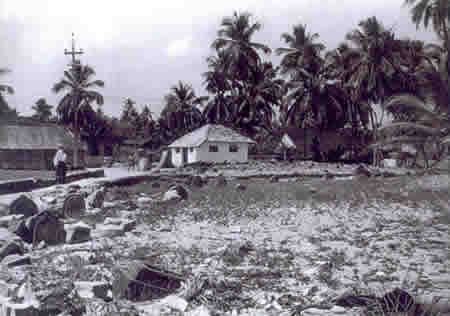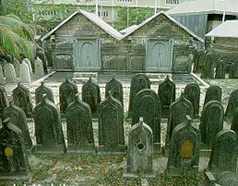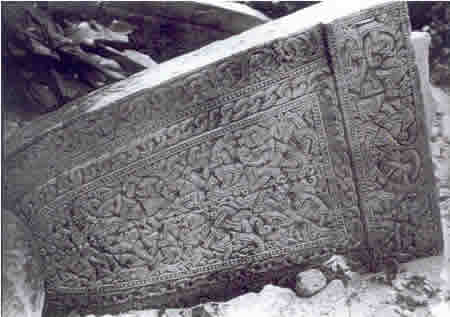|
Desecration of graveyards
Minicoy Island has not escaped the ravages of Arab-driven fundamentalist
vandalism. Inspiration from the same sources resulted in the destruction
of the Buddha images of Bamiyan in Afghanistan, a world heritage
asset.

Wholesale vandalism
of a Minicoy graveyard. Beautifully sculpted coral gravestones
were smashed and the sanctity of human remains violated.
Members of the Maldive royal dynasty of Huraagey and Hilaaly
were interred here
Source: Archeological
Survey of India
|
 "No
that's not true" "No
that's not true"
Since
this page was first uploaded the author has been contacted by a
Minicoy islander who said that the graveyard was respectfully relocated
elsewhere because the islanders were afraid to walk out of their
homes at night owing to the many ghosts that haunted the graves.
He assured the author that there was absolutely no connection between
what is seen in the photos on this page and what is referred to
here as "Wahhabi ravages". The individual said that his
family home was off the perimeter of the graveyard and insisted
that he knows the truth.
Saudi Vandalism
The following is an extract from Schwartz, Stephen. "The
Wahhabis keep tearing down Muslim holy places in Saudi Arabia".
The Daily Standard (8 June 2004). Available at
weeklystandard.com/Content/Public/Articles/000/000/004/194skrvx.asp
"Thus, the Saudis followed their conquest of Mecca
and Medina in the mid-1920s with an orgy of destruction.
They leveled the Jannat al-Baqi or Heavenly
Orchard at Medina that included graves of the Prophet
Muhammad's son Ibrahim, as well as numerous of the Prophet's
relatives and original companions. They also looted the
Prophet's Shrine in Medina and demolished the cemetery in
Mecca that included the graves of Muhammad's mother and
grandfather. They completely destroyed mausoleums, mosques,
and other honored sites, including Muhammad's own house.
It was even said that they wished to uproot the grave of
Muhammad himself...."
|
Desecration
of graveyards in the Maldives
 Tombstones in the Royal Enclosure
of the Hukuru Miskiiy graveyard in Malé. These were
spared from vandalism. The beautiful examples of Maldive stone
masonry here are much neglected now. Under fundamentalist
inspiration, any damaged tombstones are systematically dumped
into reclamation areas- a wilful and barbaric attack on a
heritage asset
Tombstones in the Royal Enclosure
of the Hukuru Miskiiy graveyard in Malé. These were
spared from vandalism. The beautiful examples of Maldive stone
masonry here are much neglected now. Under fundamentalist
inspiration, any damaged tombstones are systematically dumped
into reclamation areas- a wilful and barbaric attack on a
heritage asset |
In the
1960s and 1970s just about all the old graveyards attached to mosques
were cleared. The human remains and tombstones were dumped into
the sea and reclamation areas. The practice continues to be repeated
in many other islands. Even now many old graves in cemeteries not
attached to mosques are regularly cleared to make way for new burial
space.
In the Maldives, this practice does not appear to be driven by any
ideological beliefs. Scarcity of land for dwelling, particularly
on Malé, apparently resulted in the clearing of graveyards.
However a more respectful method for the disposal of exhumed human
remains would have been possible.
Imposition
of the dholhi veil

Dholhi-clad Minicoy women
|

A Minicoy lady in traditional
dress of the times when the native culture took precedence
over Arab colonialism
|
Almost all Minicoy women
these days wear the dholhi veil when in Minicoy. This was
introduced by a certain Malingey Hussain Didi deported from Malé
in the Twentieth Century. Hussain Didi was banished from the Maldives
for inciting sectarianism and preaching to bring the Maldives closer
to the Arab colonialist heartland. Until about 1979 most Maldive
governments had always been vigilant against Arab colonialist infiltration.
Such vigilance on the part of this writer's royal progenitors had
delivered the Maldives from the fate of proud and ancient cultures
such as Egypt, Syria and Iran. Egypt and Syria now call themselves
"Arab republics". The colonialist collaborators in Iran,
so far, have not stooped their proud heritage that low.
Buoyed by the profits of the oil crises of the 1970s, the relentless
campaigns to spread Arab colonialism by al-Qaeda-type organisations
across the world have taken a significant social toll on indigenous
ways of life. Women in the Maldives and elsewhere are now "voluntarily"
(we are told) adopting the veil in huge numbers irrespective of
temperature and humidity. (click
to view full article on veil).

A tombstone in Minicoy knocked off its pedestal.
Source: Archeological Survey
of India
|
|





 rss feed
rss feed 

 "No
that's not true"
"No
that's not true"


